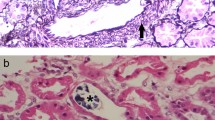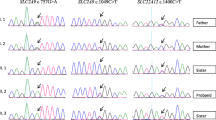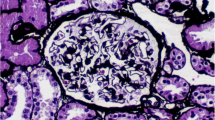Abstract
Idiopathic renal hypouricemia is a hereditary disease characterized by abnormally high renal uric acid clearance. Most patients are clinically silent, but acute renal failure (ARF), urolithiasis, or hematuria may develop. A defect in the SLC22A12 gene, which encodes the renal uric acid transporter, URAT1, is the known major cause of this disorder. We performed a mutational analysis of the SLC22A12 gene in five Korean patients with idiopathic renal hypouricemia in this study. Two patients presented with microscopic hematuria, one with uric acid urolithiasis, and one with exercise-induced ARF. One patient was asymptomatic. Three different mutations, W258X, R90H and R477H, were detected in four of the patients. However, no mutation was found in the fifth ARF patient. This is the first study of SLC22A12 mutations in a country other than Japan. W258X was found to be the predominant SLC22A12 mutation in Korean renal hypouricemia patients, as has been reported in Japan.


Similar content being viewed by others
References
Enomoto A, Kimura H, Chairoungdua A, Shigeta Y, Jutabha P, Cha SH, Hosoyamada M, Takeda M, Sekine T, Igarashi T, Matsuo H, Kikuchi Y, Oda T, Ichida K, Hosoya T, Shimokata K, Niwa T, Kanai Y, Endou H (2002) Molecular identification of a renal urate anion exchanger that regulates blood urate levels. Nature 417:447–452
Yeun JY, Hasbargen JA (1995) Renal hypouricemia: prevention of exercise-induced acute renal failure and a review of the literature. Am J Kidney Dis 25:937–946
Ohta T, Sakano T, Ogawa T, Kato J, Awaya Y, Kihara H, Kinoshita Y (2002) Exercise-induced acute renal failure with renal hypouricemia: a case report and a review of the literature. Clin Nephrol 58:313–316
Hirasaki S, Koide N, Fujita K, Ogawa H, Tsuji T (1997) Two cases of renal hypouricemia with nephrolithiasis. Intern Med 36:201–205
Hisatome I, Tanaka Y, Kotake H, Kosaka H, Hirata N, Fujimoto Y, Yoshida A, Shigemasa C, Mashiba H, Sato R, Takeda A (1993) Renal hypouricemia due to enhanced tubular secretion of urate associated with urolithiasis: successful treatment of urolithiasis by alkalization of urine K+, Na(+)-citrate. Nephron 65:578–582
Hisatome I, Tanaka Y, Ogino K, Shimoyama M, Hiroe K, Tsuboi M, Yamamoto Y, Hamada N, Kato T, Manabe I, Kinugawa T, Ohtahara A, Yoshida A, Shigemasa C, Takeda A, Sato R (1998) Hematuria in patients with renal hypouricemia. Intern Med 37:40–46
Komoda F, Sekine T, Inatomi J, Enomoto A, Endou H, Ota T, Matsuyama T, Ogata T, Ikeda M, Awazu M, Muroya K, Kamimaki I, Igarashi T (2004) The W258X mutation in SLC22A12 is the predominant cause of Japanese renal hypouricemia. Pediatr Nephrol 19:728–733
Maesaka JK, Fishbane S (1998) Regulation of renal urate excretion: a critical review. Am J Kidney Dis 32:917–933
Bairaktari ET, Kakafika AI, Pritsivelis N, Hatzidimou KG, Tsianos EV, Seferiadis KI, Elisaf MS (2003) Hypouricemia in individuals admitted to an inpatient hospital-based facility. Am J Kidney Dis 41:1225–1232
Ogino K, Hisatome M, Saitoh J, Miyamoto J, Ishiko R, Hasegawa J, Kotake H, Mashiba H (1991) Clinical significance of hypouricemia in hospitalized patients. J Med 22:76–82
Van Peenen HJ (1973) Causes of hypouricemia. Ann Intern Med 78:977–978
Hisatome I, Ogino K, Kotake H, Ishiko R, Saito M, Hasegawa J, Mashiba H, Nakamoto S (1989) Cause of persistent hypouricemia in outpatients. Nephron 51:13–16
Ichida K, Hosoyamada M, Hisatome I, Enomoto A, Hikita M, Endou H, Hosoya T (2004) Clinical and molecular analysis of patients with renal hypouricemia in Japan—Influence of URAT1 gene on urinary urate excretion. J Am Soc Nephrol 15:164–173
Tanaka M, Itoh K, Matsushita K, Matsushita K, Wakita N, Adachi M, Nonoguchi H, Kitamura K, Hosoyamada M, Endou H, Tomita K (2003) Two male siblings with hereditary renal hypouricemia and exercise-Induced ARF. Am J Kidney Dis 42:1287–1292
Iwai N, MIno Y, Hosoyamada M, Tago N, Kokubo Y, Endou H (2004) A high prevalence of renal hypouricemia caused by inactive SLC22A12 in Japanese. Kidney Int 66:935–944
Diamond HS, Paolino JS (1973) Evidence for a postsecretory reabsorptive site for uric acid in man. J Clin Invest 52:1491–1499
Levinson DJ, Sorensen LB (1980) Renal handling of uric acid in normal and gouty subject: evidence for a 4-component system. Ann Rheum Dis 39:173–179
Sperling O (1992) Renal hypouricemia: classification, tubular defect and clinical consequences. Contrib Nephrol 100:1–14
Ishikawa I (2002) Acute renal failure with severe loin pain and patchy renal ischemia after anaerobic exercise in patients with or without renal hypouricemia. Nephron 91:559–570
Hisatome I, Ogino K, Kotake H, Ishiko R, Saito M, Hasegawa J, Mashiba H, Nakamoto S (1989) Cause of persistent hypouricemia in outpatients. Nephron 51:13–16
de Vries A, Sperling O (1979) Inborn hypouricemia due to isolated renal tubular defect. Biomedicine 30:75–80
Gafter U, Zuta A, Frydman M, Lewinski UH, Levi J (1989) Hypouricemia due to familial isolated renal tubular uricosuria. Evaluation with the combined pyrazinamide–probenecid test. Miner Electrolyte Metab 15:309–314
Ames BN, Cathcart R, Schwiers E, Hochstein P (1981) Uric acid provides an antioxidant defence in humans against oxidant- and radical-causing aging and cancer: a hypothesis. Proc Natl Acad Sci USA 78:6853–6862
Davies KJ, Sevanian A, Muakkassah-Kelly SF, Hochstein P (1986) Uric acid–iron ion complexes: a new aspect of the anti-oxidant functions of uric acid. Biochem J 235:747–754
Simie MG, Jovanovic SV (1989) Antioxidation mechanisms of uric acid. J Am Chem Soc 111:5778–5782
Johnson RJ, Kang D-H, Feig D, Kivlighn S, Kanellis J, Watanabe S, Tuttle KR, Rodriguez-Iturbe B, Herrera-Acosta J, Mazzali M (2003) Is There a pathogenetic role for uric acid in hypertension and cardiovascular and renal disease? Hypertension 41:1183–1190
Cockcroft DW, Gault MH (1976) Prediction of creatinine clearance from serum creatinine. Nephron 16:31–41
Acknowledgement
This study was supported by a grant from the Korea Health 21 R and D Project, Ministry of Health and Welfare, Republic of Korea (02-PJ1-PG3-21001-0012) and a grant from Seoul National University Hospital (03-2004-024-0).
Author information
Authors and Affiliations
Corresponding author
Rights and permissions
About this article
Cite this article
Cheong, H.I., Kang, J.H., Lee, J.H. et al. Mutational analysis of idiopathic renal hypouricemia in Korea. Pediatr Nephrol 20, 886–890 (2005). https://doi.org/10.1007/s00467-005-1863-3
Received:
Revised:
Accepted:
Published:
Issue Date:
DOI: https://doi.org/10.1007/s00467-005-1863-3




